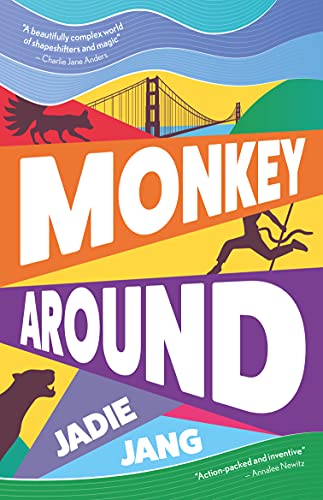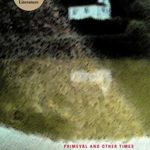Here’s another great novel from 2021 I’m just catching up with. Claire Light, writing as Jadie Jang, has re-envisioned the Monkey King from the Chinese classic, Journey to the West, as Maya MacQueen, a shape-shifter twenty-something woman of the San Francisco Bay Area during the Occupy movement of 2011. Maya, while assuming human form as a fun-loving activist/magazine editor/researcher/barista, is constantly exploring and questioning her abilities and her place in the world, and in the midst of that she’s called on to investigate a series of murders of other shapeshifters. Then it gets personal when she realizes that the mysterious killer entity has her on its list as well.
The Bay Area of Monkey Around is full of magic and centered on communities of Asian Americans and Chicanx/Latinx neighborhoods, among hundreds of uprooted and fractured cultures, languages, and traditions. They are people trying to understand who they are and what they can draw from ancestral communities to shape their lives in today’s gentrifying cities that threaten further displacement and violence. As Jadie Jang said in a blog post last year, this story grew out of a wish and need in the Trump years to depict activists and multi-ethnic America as part of this world at a time when the MAGA movement wanted to turn them into the enemy. But this is no manifesto. It’s a compelling and deeply human search into how people pull their lives together in broken times.
Monkey Around pulls us directly into the action as Maya battles a gang member on a rooftop of a building where she suspects the missing Dalisay, a shapeshifter, might be held captive. We witness her incredible strength and agility in her “default” monkey form and her ability to shape hairs from her body into any object she needs (here it’s a long cable with camera attached so she can peer inside the building). But she can also become a shadow, turn invisible, summon a cloud and fly across the Bay when she’s in a hurry and assume almost any other form she needs to get through the fights she keeps getting into. She can even make herself look and sound exactly like another person, but most of the time she lives as a young woman trying to make sense of her supernatural nature and human feelings.
Maya is preoccupied with issues of self-doubt and impostor syndrome while also being a powerful magical creature (she is typically slow to realize or accept the scale of her power and its implications for her leadership). Maya calls on her allies, especially the human scholar of magic named Ayo, the red fox shapeshifter Todd and mesmerizing poet-performer Tez who has the power of a nagual in his veins. Together, and with sometimes conflicting motives, they search for an essence-eating shadow creature of great power who is killing off one shape-shifter after another. They are desperate to figure out what that creature is, why it is choosing its victims and how they might defeat it.
Monkey Around captures a sense of place as a living presence better than anything I’ve read in a long time. There is a spirit of the Bay that, like the other characters in the story, is beginning to come into its own in response to the pressures of an economy based on endless growth and inequality as well as the pervasive presence of supernatural beings. Early in the story, Maya looks out over San Francisco and can sense the coalescing of the social and spiritual in what she believes will be a great awakening.
“So that fall, when word of the Occupy Wall Street protest tore through the air like lightning, and Oakland (and even San Francisco) rose up in response, I felt like something was waking up: some better angel of our nature, something militant in the spirit of the Bay. I felt like I, like we, were on the threshold of a new era, a new mass movement, one where life would take a huge leap forward. The peace of late-night Chinatown overlay that excitement. I breathed them both in.”
Monkey Around, Kindle edition, Location 188
An important supernatural element of the story centers on a power stick which seems to exert a deep feeling of attachment in anyone who holds it. That’s a familiar trope from Tolkien on, but here it’s linked to indigenous traditions going back to the Aztecs. Tez, as the oldest surviving member of his family, seems bound to a destiny as the stick’s natural owner, but he resists following in the footsteps of the elders of his extended family. His contemporary desire to focus on his writing and performing clashes with what his family regards as his unique responsibility, a duty that links him to an ancient past that is only dimly understood in today’s fractured world. His struggle becomes central to the story and parallels the questioning of Maya and other characters about who they are or should be.
I found the novel by turns exciting, hilarious and always interesting, especially when it probed the origins of different community traditions, both human and supernatural. There were some rough spots when there was a lot of backfilling of information through explanations by the scholar character or others. Most of those passages were well done, but there were a few that could have been re-engineered to fit more smoothly into the flow of action.
Maya herself remains for me a deeply interesting character, as she struggles with human relationships and her violence-prone and riotous monkey nature to burst into action no matter the consequences. There are times when her magical self makes use of people, especially when she impersonates another character, and that clashes with her hopes to build relationships with the people she’s been tricking, especially Tez. This may be a problem limited to a “supernat” but the fallout of manipulating people you’re close to is completely human.
I’ve read there’s a sequel in the works, and that’s good news. Jadie Jang has created a special place in urban fantasy with her blending of exciting action, contemporary social movements, supernatural beings, the character of Maya MacQueen herself and the developing spirit of the Bay. There’s plenty of material for a great series.





Leave a Reply